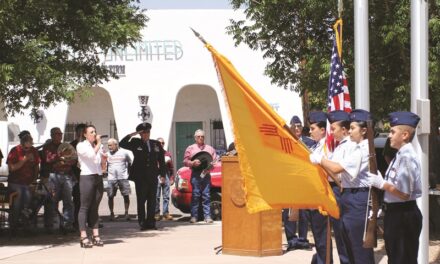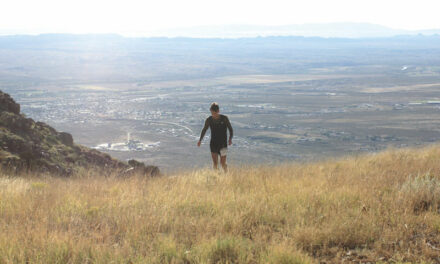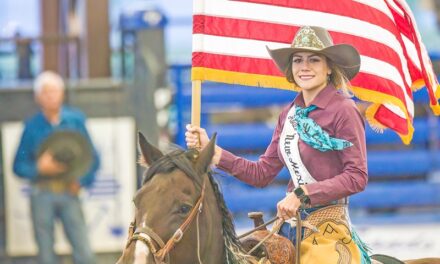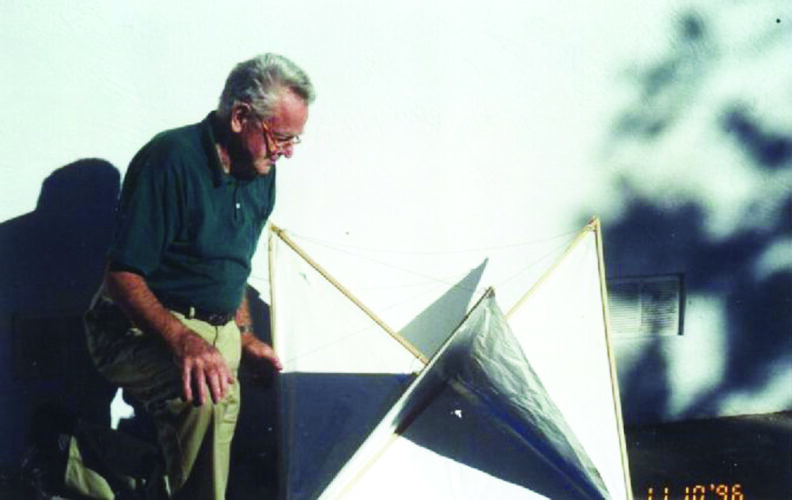
Charles B. Moore displays a ML307C reflector in 1996.
Photos courtesy of Dave Thomas
On Thursday, July 8th, 2021, the city of Roswell will celebrate the 74th anniversary of the recovery of some curious debris nearby the town. Something certainly did land in the desert near Roswell in the summer of 1947. Was it a crashed alien spaceship, as most of the celebrants in Roswell dearly want to believe? Or was it something more mundane, more Earthly?
It turns out that what we call the “Roswell Incident” is due to a physics experiment launched by a man who would one day become a respected New Mexico Tech physics professor. The ill-fated device was lost shortly after being deployed, but its later discovery by a Roswell area rancher led to what many now regard as the “smoking gun” proving alien visitation. How did a future resident of Socorro help bring about “Roswell”? And what was it, really?
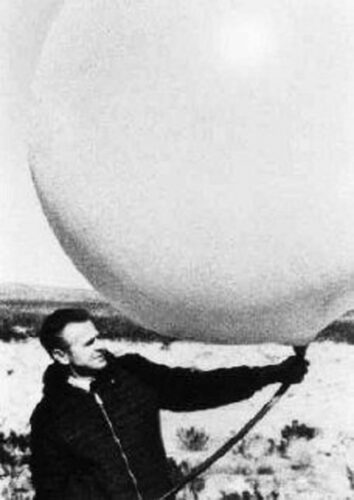
Moore flying a balloon in 1947.
The story really begins on August 27th, 1883, with the massive eruption of the Krakatoa volcano in Indonesia. That eruption produced a massive tsunami which killed upwards of 35,000 people. The blast was so loud that it was heard in Australia, and even at the island of Rodriques, some 3,000 miles away.
In 1947, that curious historical footnote was noticed by Athelstan Spilhaus, a South African-American geophysicist who became a U.S. citizen in 1946. Spilhaus created and drew the popular “Our New Age” color cartoon, which was carried in the comics sections of 93 Sunday papers around the nation. President John F. Kennedy remarked to Spilhaus that “The only science I ever learned was from your comic strip in the Boston Globe.” In 1947, Spilhaus was part of a team trying hard to develop a way to detect Soviet nuclear tests. Spilhaus analyzed the old reports from Krakatoa, and figured out that the loud sound of the eruption propagated so far because it was confined to a layer of air about 50,000 feet up, between the troposphere and the stratosphere. The scientist realized that an array of three or more microphones, suspended in this sound-conducting tropopause, could triangulate the position of Russian A-bomb bursts.
The first attempts to deploy microphones to detect N-tests, part of top-secret Project MOGUL, were made in New Jersey. Those launches were plagued by severe winds, so the whole project was moved to Alamogordo, New Mexico. And that’s where Charles B. Moore, then a grad student at New York University, came to launch Flight # 4 on June 4th, 1947.
Moore had done some excellent work in atmospheric physics, and was a key member of the team charged with figuring how to deploy the sound sensors with balloon trains. The device launched that June morning was some 600 feet tall (about the length of two football fields end-to-end), and included over two dozen small weather balloons, along with several parachutes, connecting ropes, and – most importantly – three radar reflectors. It was certainly no “ordinary weather balloon.”
The radar reflectors had wooden struts along three perpendicular directions, much like the shape of a “Jacks” child’s toy. Reflective parchment was affixed to the struts to make eight corner-cubes, which reflected any radar impulses from the ground back to their source. As the reflectors in the train spun around, they would have created a flashing “blip” on radar monitors. It turns out that these particular radar reflectors were actually produced by a toy company, Merrick Manufacturing of Manhattan. During World War II, the “Military-Industrial Complex” actually included some small mom-and-pop companies like this small toy store. When the Army Signal Corps asked the company to strengthen their reflectors, Merrick used some tape they had lying around to reinforce them. This tape was decorated with fanciful geometric symbols, which Charlie Moore himself recalled seeing on the MOGUL balloon train reflectors, with more than a little amusement.

Photo of Maj. Jesse Marcel’s drawing.
On the day of the June 4th launch, Moore’s device was tracked to somewhere near Arabela, NM, before it was lost to history. As the balloon train descended, bushes ripped pieces off of the balloons, parachutes, and reflectors, resulting in a debris field hundreds of yards long. As the debris baked in the hot New Mexico sun, however, events in the Pacific Northwest would change everything.
About three weeks after the demise of Flight #4, on June 24th, 1947, pilot Kenneth Arnold reported seeing a series of strange lights near Mt. Rainier, Washington. This launched America’s first big “UFO Flap,” the summer of the “Flying Disks,” with new reports of anomalies in the sky appearing almost every day in the papers. A $3,000 reward was offered for physical evidence of a disk, and that might be what prompted Roswell-area rancher Mac Brazel to take some of the debris he’d found on the Foster Ranch to Roswell. Brazel was directed by the sheriff to take the debris to the Roswell Army Air Field. Army Major Jesse Marcel became interested, and accompanied Brazel back out to the debris field. More than anything else, it was the “alien hieroglyphics” – the curious geometric markings on the reflectors – which convinced Marcel that this was indeed a Flying Disk. Marcel’s excitement led to a press release, and Roswell became famous, if only for a day. When General Roger Ramey of the Eighth Air Force in Fort Worth Texas heard of the news, however, he demanded that Marcel and the debris be brought to him immediately.
And so it was that on the afternoon of Tuesday, July 8th, 1947, the remains of Moore’s lost physics experiment came to be strewn about on the floor of a general’s office in Fort Worth. The general called in his weather officer, Irving Newton, to identify the remains, and Newton promptly declared that the “flying disk” was simply a normal “RAWIN” radar reflector. The published pictures of the debris all show material entirely consistent with a Project MOGUL balloon train after weeks of exposure to the desert. Significantly, Major Marcel pointed to the strange markings on the reflector sticks, and tried to convince Newton that they were, indeed, alien writing. The weather officer was not convinced, however. The excitement subsided, and it wasn’t until decades later, in 1979, that Roswell re-emerged as a major UFO sighting, replete with new tales of alien bodies, autopsies, and sinister coverups.

Moore received an honorary doctorate degree in 2003.
The “Roswell Incident” boils down to a few pounds of flimsy material, hardly the makings of an interstellar spaceship. Marcel himself declared that the debris was not an airplane or a missile; it was the “alien writing” which convinced him the material was not from earth, and therefore a Flying Disk. Almost all pro-UFO authors claim that the debris in General Ramey’s office was a cover-up – a crummy radar reflector the army had stashed in a storeroom, while the real debris was carted off to Wright Field in Ohio. In Showtime’s “Roswell” movie of the 90’s, Major Marcel (played by Kyle MacLachlan) looks totally humiliated as he is forced to pose with the “hoax” radar reflector. In real life, however, Marcel was pointing to that same banged-up radar reflector, trying to convince Irving Newton it bore alien writings. More than anything else, this scene illustrates the emptiness of the Roswell story.
Project MOGUL was itself plagued by problems and difficulties. While the project did record a U.S. nuclear test at a distance of over 6,000 miles away, in the South Pacific, it never was used to record Soviet N-tests. That task eventually fell to seismometers. In addition to tracking nuclear tests, post-war earthquake measurements revealed a vast system of continental plates, and led to the development of Plate Tectonics. Today, Socorro houses the IRIS/PASSCAL Instrument Center, one of the world’s premiere repositories of seismic devices.
Moore went on to become a respected professor of physics at New Mexico Tech. He worked with physicist Bernard Vonnegut on projects such as cloud-seeding; it is thought that such work inspired Bernie Vonnegut’s brother, Kurt, to come up with the concept of “Ice-Nine” in his novel Cat’s Cradle. Moore’s research on lightning rods prompted the industry to adopt blunter rods rather than the sharp-tipped rods of antiquity, earning Moore the Lifetime Achievement Award of the Atmospheric Electricity Community. He flew balloons to the very edge of space, and received the Otto C. Winzen Lifetime Achievement Award of the American Institute of Aeronautics and Astronautics. Charlie Moore was awarded an honorary doctorate by New Mexico Tech in 2003. He died in 2010 after a long illness.
As you read about Roswell’s big 74th Anniversary gala, remember – the whole thing is a celebration of a wayward physics experiment, just one scene of many in the long and accomplished life of Socorro’s own Charles B. Moore.
Dave Thomas is a scientist with New Mexico Tech’s IRIS-Passcal, and teaches a class on Science and Pseudoscience at NM Tech.
